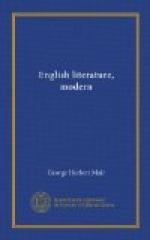The seventeenth century, taking stock in some such fashion of its artistic possessions, found some things it were vain to try to do. It could add nothing to the accomplishment of the English sonnet, so it hardly tried; with the exception of a few sonnets in the Italian form of Milton, the century can show us nothing in this mode of verse. The literary drama was brought to perfection in the early years of it by the surviving Elizabethans; later decades could add nothing to it but licence, and as we saw, the licences they added hastened its destruction. But in other forms the poets of the new time experimented eagerly, and in the stress of experiment, poetry which under Elizabeth had been integral and coherent split into different schools. As the period of the Renaissance was also that of the Reformation it was only natural a determined effort should sooner or later be made to use poetry for religious purposes. The earliest English hymn writing, our first devotional verse in the vernacular, belongs to this time, and a Catholic and religious school of lyricism grew and flourished beside the pagan neo-classical writers. From the tumult of experiment three schools disengage themselves, the school of Spenser, the school of Jonson, and the school of Donne.
At the outset of the century Spenser’s influence was triumphant and predominant; his was the main stream with which the other poetic influences of the time merely mingled. His popularity is referable to qualities other than those which belonged peculiarly to his talent as a poet. Puritans loved his religious ardour, and in those Puritan households where the stricter conception of the diabolical nature of all poetry had not penetrated, his works were read—standing on a shelf, may be, between the new translation of the Bible and Sylvester’s translation of the French poet Du Bartas’ work on the creation, that had a large popularity at that time as family reading. Probably the Puritans were as blind to the sensuousness of Spenser’s language and imagery as they were (and are) to the same qualities in the Bible itself. The Fairy Queen would easily achieve innocuousness amongst those who can find nothing but an allegory of the Church in the “Song of Songs.” His followers made their allegory a great deal plainer than he had done his. In his poem called The Purple Island, Phineas Fletcher, a Puritan imitator of Spenser in Cambridge, essayed to set forth the struggle of the soul at grip with evil, a battle in which the body—the “Purple Island”—is the field. To a modern reader it is a desolating and at times a mildly amusing book, in which everything from the liver to the seven deadly sins is personified; in which after four books of allegorized contemporary anatomy and physiology, the will (Voletta) engages in a struggle with Satan and conquers by the help of Christ and King James! The allegory is clever—too clever—and the author can paint a pleasant picture, but on the whole he was happier in his pastoral work. His brother Giles made a better attempt at the Spenserian manner. His long poem, Christ’s Victory and Death, shows for all its carefully Protestant tone high qualities of mysticism; across it Spenser and Milton join hands.




